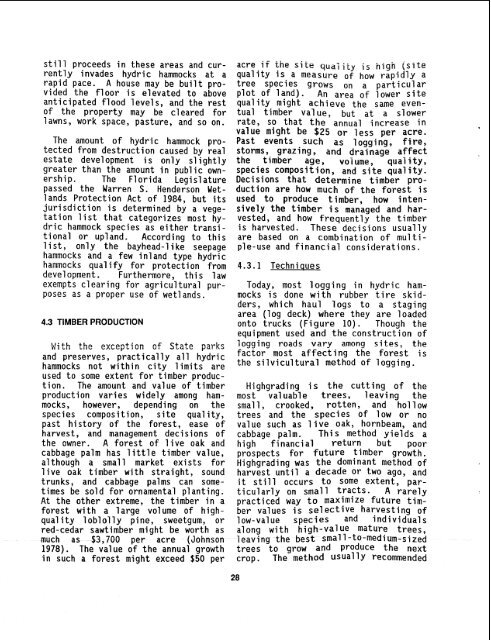a Guide to Management - USGS National Wetlands Research Center
a Guide to Management - USGS National Wetlands Research Center
a Guide to Management - USGS National Wetlands Research Center
You also want an ePaper? Increase the reach of your titles
YUMPU automatically turns print PDFs into web optimized ePapers that Google loves.
still proceeds in these areas and cur-<br />
rently invades hydric hammocks at a<br />
rapid pace. A house may be built pro-<br />
vided the floor is elevated <strong>to</strong> above<br />
anticipated flood levels, and the rest<br />
of the property may be cleared for<br />
lawns, work space, pasture, and so on.<br />
The amount of hydric hammock pro-<br />
tected from destruction caused by real<br />
estate development is only sl ightly<br />
greater than the amount in public own-<br />
ership. The Florida Legislature<br />
passed the Warren S. Henderson Wet-<br />
lands Protection Act of 1984, but its<br />
jurisdiction is determined by a vege-<br />
tation list that categorizes most hy-<br />
dric hammock species as either transi -<br />
tional or upland. According <strong>to</strong> this<br />
1 i st, only the bayhead-1 i ke seepage<br />
hammocks and a few inland type hydric<br />
hammocks qual ify for protection from<br />
devel opment . Furthermore, thi s 1 aw<br />
exempts clearing for agricultural pur-<br />
poses as a proper use of wet1 ands.<br />
4.3 TIMBER PRODUCTION<br />
hlith the exception of State parks<br />
and preserves, practically a1 1 hydric<br />
hammocks not within city limits are<br />
used <strong>to</strong> some extent for timber produc-<br />
tion. The amount and value of timber<br />
production varies widely among ham-<br />
mocks, however, depending on the<br />
species composition, site quality,<br />
past his<strong>to</strong>ry of the forest, ease of<br />
harvest, and management decisions of<br />
the owner. A forest of live oak and<br />
cabbage palm has little timber value,<br />
although a small market exists for<br />
live oak timber with straight, sound<br />
trunks, and cabbage palms can some-<br />
times be sold for ornamental planting.<br />
At the other extreme, the timber in a<br />
forest with a large volume of high-<br />
qua1 i ty 1 oblol ly pine, sweetgum, or<br />
red-cedar sawtimber might be worth as<br />
much as $3,700 per acre (Johnson<br />
1978). The value of the annual growth<br />
in such a forest might exceed $50 per<br />
acre if the site qudiiiy i s high (slte<br />
qual ity is a measure of how rapidly a<br />
tree species grows on a particular<br />
plot of land). An area of lower site<br />
qual ity might achieve the same even-<br />
tual timber value, but at a slower<br />
rate, so that the annual increase in<br />
value might be $25 or less per acre.<br />
Past events such as logging, fire,<br />
s<strong>to</strong>rms, grazing, and drainage affect<br />
the timber age, volume, qua1 ity,<br />
species composition, and site quality.<br />
Decisions that determine timber pro-<br />
duction are how much of the forest is<br />
used <strong>to</strong> produce timber, how inten-<br />
sively the timber is managed and har-<br />
vested, and how frequently the timber<br />
is harvested. These decisions usual ly<br />
are based on a combination of mu1 ti-<br />
ple-use and financi a1 considerations.<br />
4.3.1 Techniaues<br />
Today, most logging in hydric ham-<br />
mocks is done with rubber tire skid-<br />
ders, which haul logs <strong>to</strong> a staging<br />
area (log deck) where they are loaded<br />
on<strong>to</strong> trucks (Figure 10). Though the<br />
equipment used and the construction of<br />
logging roads vary among sites, the<br />
fac<strong>to</strong>r most affecting the forest is<br />
the silvicul tural method of logging.<br />
Highgrading is the cutting of the<br />
most valuable trees, leaving the<br />
small, crooked, rotten, and hol low<br />
trees and the species of low or no<br />
value such as live oak, hornbeam, and<br />
cabbage palm. This method yields a<br />
high financial return but poor<br />
prospects for future timber growth.<br />
Highgrading was the dominant method of<br />
harvest until a decade or two ago, and<br />
it still occurs <strong>to</strong> some extent, par-<br />
ticularly on small tracts. A rarely<br />
practiced way <strong>to</strong> maximize future tim-<br />
ber values is selective harvesting of<br />
low-value species and individuals<br />
along with high-val ue mature trees,<br />
leaving the best small -<strong>to</strong>-medium-sized<br />
trees <strong>to</strong> grow and produce the next<br />
crop. The method usual 1~ recommended

















